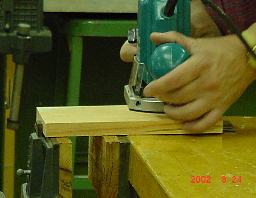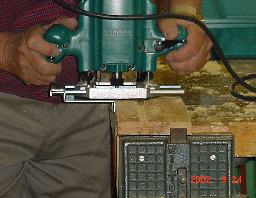|
Home
Router
|

|
The portable router is a tool that is used to
cut various edges on stock as well as grooves in
the stock. The router can also be entered
into the stock like a drill and then be moved
around to cut a recess in the surfaces.
Various router uses include: Dado cuts, Cove
moldings, Rabbet cuts, Dovetail joints, Free hand
lettering, and Decorative cuts.
The following is a procedure for the safe use of
the portable router when doing edge and dado
cuts. Also included are the controls,
potential hazards as well as safety practices.s
available.
|
Controls
The following are the controls that are used to operate the
portable router:
- An On/Off switch
- Bit depth adjustment
- Bit depth lock
- Handles for manually controlling bit height
- Removable edge guides for specialized cutting such as
dadoes
- Router wrenches for removing and installing bits
Operation
The following are instructions on how to perform the cuts
associated with the router.
Performing Edge Cuts:
- Choose correct bit according to the type of edge cut
that will be performed.
- Using two router wrenches of appropriate size loosen
the bit holder by holding one wrench steady and turning
the other in the appropriate direction. Note: Make
sure router is unplugged before making any
adjustments.
- Install correct bit.
- Tighten bit holder by holding one wrench steady
and turning the other in the appropriate direction.
Note: be sure not to over tighten bit holder on
bit. Over tightening will cause eventual bit holder
damage.
- Clamp a piece of stock to a table or other
holding device in order to keep stock fixed during the
routing.
- Make sure the edge being routed is free of any
obstructions.
- With the router on the stock and plugged in,
set the correct bit depth using the bit depth adjustment
and bit depth lock.
- Turn router on and begin edge cut.
Performing Dado Cuts:
- Follow steps 1- 4 in edge cuts to install correct
cutting bit for the desired cut.
- Install a straight edge guide on the router.
- Clamp the stock at a point where no obstructions will
interfere with router operation.
- Adjust the guide to the correct horizontal distance
(from the edge of the stock to where the dado will be
cut).
- Place the router on the stock, turn it on, and make
the cut for the desired length.
|
The edge of the stock is being routed.
Notice the vice and table tabs keeping the stock in
place. Precautions were taken to ensure edge
being routed is free of obstructions.
|
With the straight edge guide installed at the
correct side depth, the dado can be cut.
Notice the firm grip on the router.
|
Potential Hazards
The following are the potential hazards that are associated
with the use of the portable router:
- Entanglement of long hair and loose clothing in the
router bit.
- Flying wood chips.
- Kickback of router or stock.
- Bit damage from foreign objects.
Safety Practices
The following are safety practices that should always be
acknowledged and obeyed when using the portable
router:
- Remove all dangling jewelry or articles.
- Roll up long sleeves and secure other loose
clothing.
- Secure long hair.
- Wear safety glasses at all times.
- Ensure that you know the correct procedure for
performing every router operation.
- Unplug the router when installing or adjusting
the bit.
- Ensure that the bit is properly installed
before turning on the power.
- Make sure the router venting holes are not
plugged or obstructed.
- Be sure that stock is free of all paint, nails,
grit, loose knots, or other foreign materials.
- Securely clamp stock in a vice or onto a working
surface.
- Ensure there are no obstructions in the path of the
router.
- Do not turn on the power until you are in a working
position and have a firm grip on the router.
- Turn the router off when it is not in use.
References
Feirer, John L. (1988). Cabinetmaking and Millwork.
Glencoe/McGraw-Hill. Peoria, IL.
Zaner, John. (2002). Router Safety sheet.
University of Southern Maine
ITT 252 - Materials Processing
Department of Technology
University of Southern Maine
Prepared by Andrew McDowell, 10/22/2002
|


